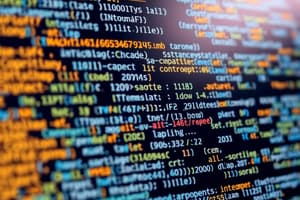Podcast
Questions and Answers
What does the 1st generation of programming language use?
What does the 1st generation of programming language use?
Binary codes consisting of zeroes and ones
Which of the following languages are from the 2nd generation?
Which of the following languages are from the 2nd generation?
- TASM (correct)
- MASM (correct)
- FORTRAN
- C++
What characterizes 3rd generation programming languages?
What characterizes 3rd generation programming languages?
- They use a compiler to translate source code. (correct)
- They are difficult to read and maintain.
- They utilize binary code directly.
- They are highly dependent on specific computers.
Assembly language is a high-level language.
Assembly language is a high-level language.
Which languages are examples of 4th generation programming languages?
Which languages are examples of 4th generation programming languages?
What type of errors occur due to faulty syntax in programming?
What type of errors occur due to faulty syntax in programming?
What is the focus of 5th generation programming?
What is the focus of 5th generation programming?
Programming languages are used to communicate instructions to a ______.
Programming languages are used to communicate instructions to a ______.
Match the programming languages with their classifications:
Match the programming languages with their classifications:
Flashcards are hidden until you start studying
Study Notes
Generations of Programming Language
-
1st Generation: Machine Language
- Utilizes binary code consisting of zeros and ones
- Directly understood and executed by computers
- Machine dependent and classified as low-level language
-
2nd Generation: Assembly Language
- Employs mnemonics or short words for commands
- Must be translated to machine code using an assembler
- Also categorized as low-level language; examples include TASM and MASM
-
3rd Generation: High-Level Language
- More abstract, less dependent on specific computer architecture
- Closer to human language; easier to read, write, and maintain
- Requires a compiler to convert source code to machine code
- Examples include FORTRAN, BASIC, COBOL, PASCAL, C, C++, ALGOL, ADA, JAVA
-
4th Generation: Object-Oriented Programming Language
- Codes are organized around objects
- Event-driven, where outcomes are triggered by events
- Examples include JAVA, C+, C#, Visual Basic, VB.NET
-
5th Generation: Logic Programming
- Focused on problem-solving within constraints and rules
- Involves artificial intelligence concepts with knowledge bases
- Examples include PROLOG, MERCURY, LISP
Programming Errors
-
Syntax Errors
- Occur when language rules are not followed
-
Semantic Errors
- Result from inappropriate use of program statements
-
Logical Errors
- Happen when the program deviates from intended specifications
-
Compile Time Errors
- Arise during compilation due to syntax or type-related issues
-
Runtime Errors
- Occur during execution, often caused by unexpected conditions (e.g., division by zero)
What is Programming Language?
- An artificial language created to communicate instructions to machines
- Used for developing programs that govern machine behavior and articulate algorithms accurately
- Functions as software for crafting additional software
Programming Paradigms
- Imperative/Procedural Programming
- Involves commanding the system through explicit instructions
- Focuses on program states and actions that alter these states
Types of Programming Languages
- Machine Language
- The foundational binary language conceptualized by Gottfried Wilhelm Leibniz in 1689, published in 1703
Studying That Suits You
Use AI to generate personalized quizzes and flashcards to suit your learning preferences.



